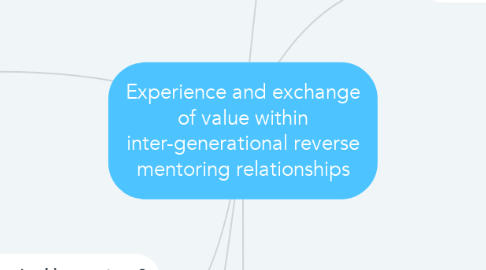
1. Generations and diversity
1.1. Generational culture
1.1.1. How culture has affected relationship with organisations
1.1.1.1. Culture and motivation to participate in RM
1.2. Leading diverse workforce
1.3. Diversity in leadership
1.4. Generations and diversity
1.5. How does TM support diversity?
1.5.1. Does RM support diversity any better?
2. Reverse mentoring
2.1. History origins
2.1.1. Power in the relationship
2.1.1.1. Contrast between TM and RM
2.1.1.1.1. Is contrast clean or messy?
2.2. Problems and gaps in understanding
2.3. Progression over time
2.4. Relationship between parties
2.4.1. RM Mentors
2.4.1.1. What's in it for me?
2.4.1.1.1. Potential impact on organisations
2.4.1.2. Substantive
2.4.1.3. Psychosocial
2.4.2. RM Mentees
2.4.2.1. What's in it for me?
2.4.2.1.1. Potential impact on organisations
2.4.2.2. Psychosocial
2.4.2.3. Substantive
2.4.3. Academic theories of motivation
2.4.4. AOC affective orientation
2.4.5. LMX leader member exchange
2.4.6. Duration, driving force, duties and length of relationship
3. Power exercised by mentors & mentees
3.1. Power of RM mentee
3.2. Power of RM mentor
3.3. How power manifests through conflict
3.4. Power tensions and contradictions
4. Traditional mentoring, definitions and qualities
4.1. Claimed benefits
4.2. Definitions
4.3. Activities
4.4. Relationship between parties
4.4.1. Duration, driving force, duties and length of relationship
4.4.2. Substantive assistance
4.5. Psychosocial support
5. Questions arising from literature
5.1. How do deficiencies in TM mentees present themselves in RM relationships - how do they compensate and are the RM mentees stepping into co-mentoring role
5.2. To what extent is organisational seniority a factor in relationship?
5.2.1. What does organisational seniority bring as advantage and disadvantage
5.3. Old young paradigm for mentoring broken - so what?
5.3.1. what is the connection between age and seniority
5.4. Is teaching skills same as mentoring
5.5. Is reverse mentoring a clean opposite of traditional practice?
5.5.1. What elements of not present in TM but gained through RM?
5.5.1.1. What elements of TM are lost in RM
5.5.1.2. Are there benefits arising from this
5.5.1.3. How do these benefits occur, what are the key factors?
5.5.2. How do the roles of mentor and mentee compare?

